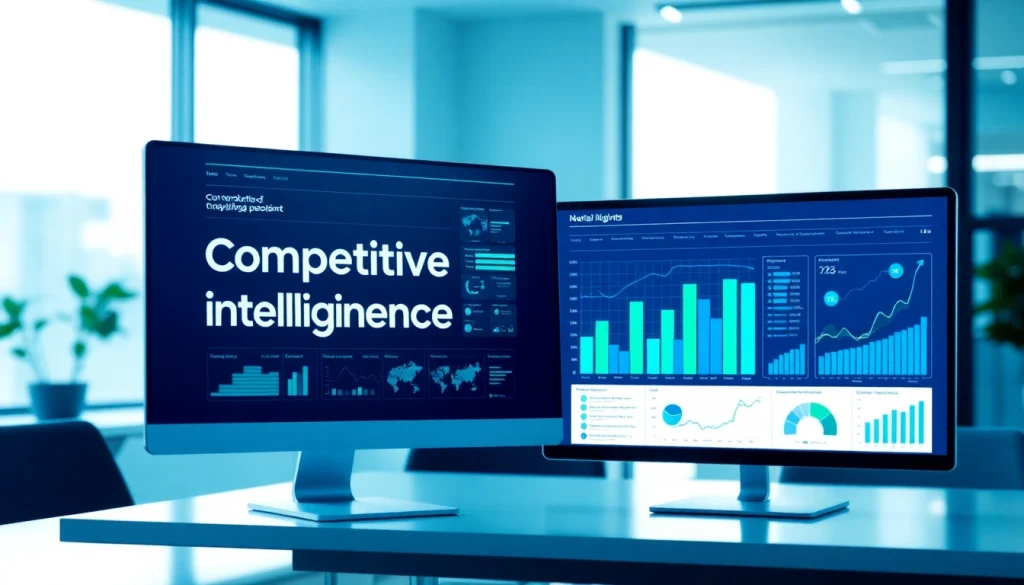Understanding Competitive Intelligence
Definition and Importance
Competitive intelligence (CI) is the process of collecting, analyzing, and utilizing information about competitors, industry trends, and market dynamics to inform strategic decision-making within an organization. By leveraging competitive intelligence services, businesses can gain valuable insights into their competitive landscape, helping to identify opportunities for growth, enhance market positioning, and mitigate risks. In today’s fast-paced and interconnected market environment, the ability to anticipate competitors’ moves and adapt to changing market conditions is crucial for sustainability and success.
Key Components of Competitive Intelligence
Competitive intelligence encompasses several key components, including:
- Market Analysis: Understanding the broader market dynamics, including trends, customer preferences, and economic factors that influence buyer behavior.
- Competitor Analysis: In-depth profiling of major competitors, their product offerings, pricing strategies, market share, and strengths and weaknesses.
- Industry Trends: Monitoring and forecasting shifts in industry dynamics, technological advancements, and regulatory changes that can affect the business landscape.
- Customer Insights: Analyzing customer feedback and sentiment to determine how competitors engage their audience and what gaps may exist in the market.
Legal and Ethical Considerations
While competitive intelligence involves gathering information about competitors, it’s essential to operate within legal and ethical boundaries. Practices such as industrial espionage are illegal and ethical breaches can harm a company’s reputation. Organizations must adhere to guidelines that allow for the collection of public information, such as:
- Studying public financial reports and marketing materials.
- Attending trade shows and conferences to gain insights.
- Utilizing open-source intelligence and legal databases.
Types of Competitive Intelligence Services
Market Analysis and Research
Market analysis involves conducting comprehensive research to understand the competitive landscape and market dynamics. This service enables businesses to:
- Identify market trends and emerging technologies.
- Analyze customer demographics and buying behavior.
- Evaluate potential new market segments for expansion.
For example, organizations can utilize tools and methodologies, such as SWOT analysis (Strengths, Weaknesses, Opportunities, Threats), to assess their positions in relation to the market and competitors.
Competitor Profiling
Competitor profiling provides an in-depth look into direct and indirect competitors. This service should include:
- Analysis of competitors’ product offerings, features, and pricing models.
- Assessment of competitors’ marketing strategies and customer engagement efforts.
- Research into competitors’ strengths, weaknesses, and market share.
Armed with this information, businesses can tailor their strategies to capitalize on identified weaknesses in competitors’ offerings or adjust their value propositions for enhanced competitiveness.
Trend Analysis and Forecasting
Understanding trends is critical for any business aiming to stay ahead. Trend analysis involves studying historical data to forecast future movements in the market. This process includes:
- Utilizing statistical models to predict shifts in consumer behavior and market trends.
- Regularly revising forecasts based on new data and market conditions.
- Leveraging insights from social media and digital engagement to predict customer interest patterns.
How to Choose the Right Competitive Intelligence Service
Assessing Your Business Needs
Different organizations have unique requirements based on their size, industry, and strategic goals. Some considerations include:
- What specific insights do you need? (e.g., pricing, product features)
- What outcomes do you hope to achieve? (e.g., improved product-market fit, enhanced marketing strategies)
- What resources do you have available to implement CI services? (in-house teams vs. outsourced services)
Evaluating Service Providers
When choosing a competitive intelligence service provider, evaluate potential partners on criteria such as:
- Experience and Expertise: Their track record in your industry can be a significant asset.
- Tools and Methodologies: Ensure they use up-to-date, reliable tools for data collection and analysis.
- Client Testimonials: Seek out feedback from previous clients to gauge success rates and satisfaction.
Common Pitfalls to Avoid
There are notable pitfalls that businesses should avoid when investing in competitive intelligence services. These include:
- Overlooking internal team insights, which can provide valuable contextual information.
- Failing to continuously adjust strategies based on the insights gathered, leading to missed opportunities.
- Ignoring ethical boundaries in data collection, which can lead to legal issues or backlash.
Implementing Competitive Intelligence in Your Business Strategy
Integration with Existing Processes
Integrating competitive intelligence findings into daily operations is crucial for maximizing ROI. This can involve:
- Embedding CI findings in product development cycles.
- Incorporating insights into strategic planning sessions.
- Sharing information across departments to foster a culture of informed decision-making.
Measuring the Impact and Effectiveness
To assess the effectiveness of competitive intelligence initiatives, businesses should establish measurable metrics, such as:
- Market share growth following implementation of CI insights.
- Increased engagement rates from targeted marketing campaigns.
- Improved product reception based on consumer feedback.
Adjusting Strategies Based on Insights
Business strategies must be agile enough to adapt to CI insights. Steps include:
- Regularly reviewing competitive landscapes and adjusting marketing strategies.
- Staying alert to shifts in consumer preferences and altering products accordingly.
- Utilizing segmented data to tailor marketing efforts toward specific demographics.
Case Studies: Success Stories in Competitive Intelligence
Industry Leaders Leveraging Competitive Intelligence
Many companies successfully utilize competitive intelligence to gain a market edge. For instance, a leading tech firm used CI services to analyze competitors’ software and feature releases, resulting in a successful product development cycle that quickly adapted to emerging market needs, leading to a significant increase in user adoption rates.
Lessons Learned from Real-World Applications
Real-world applications of competitive intelligence demonstrate valuable lessons, such as:
- The importance of regularly updating intelligence to reflect changing market conditions.
- Engaging cross-functional teams to gain diverse insights into competitive positioning.
- Building a robust framework that allows for the quick dissemination of intelligence across all levels of the organization.
Future Trends in Competitive Intelligence
The future of competitive intelligence is set to be influenced by several emergent trends, including:
- Integration of artificial intelligence and machine learning to automate data analysis.
- Increased focus on analyzing social media sentiment to gauge public perception of brands and products.
- A shift towards more collaborative CI processes that involve multiple stakeholders within and outside the organization.





